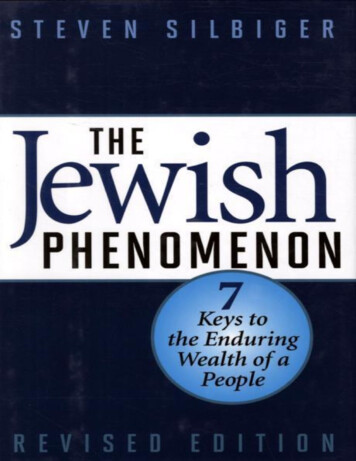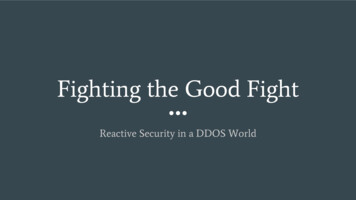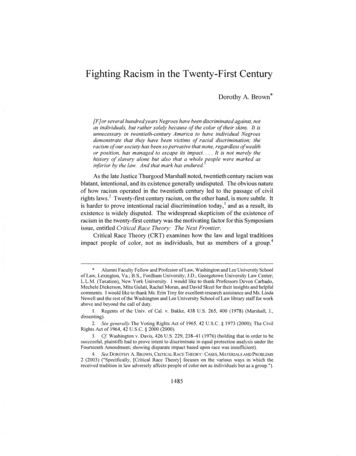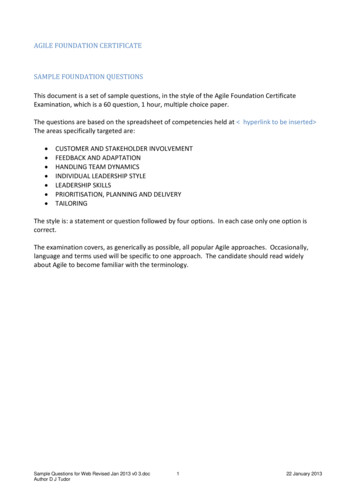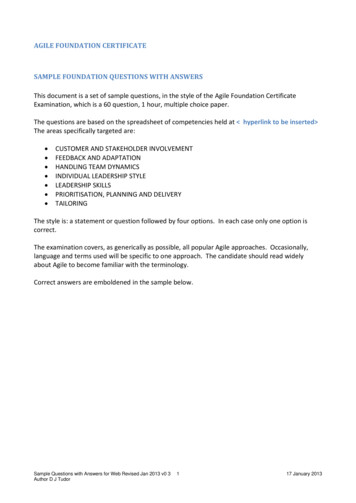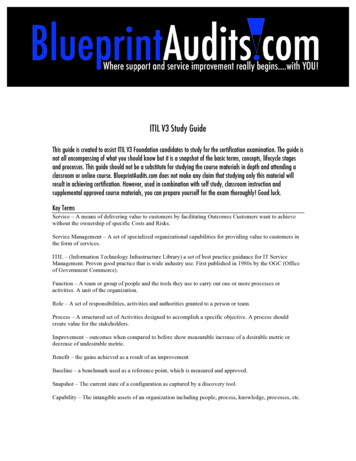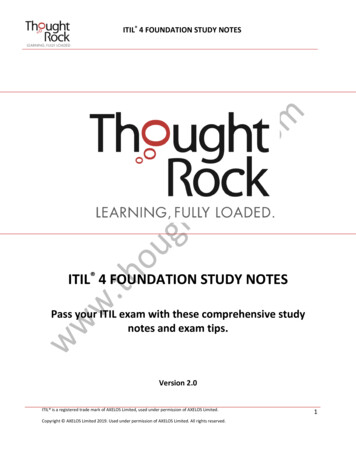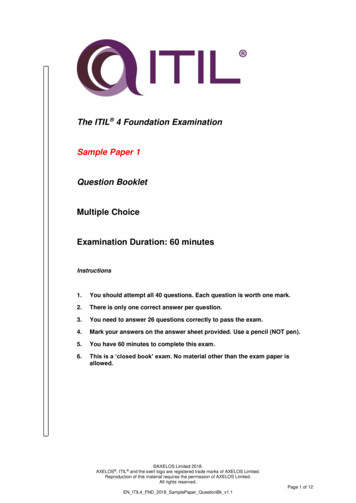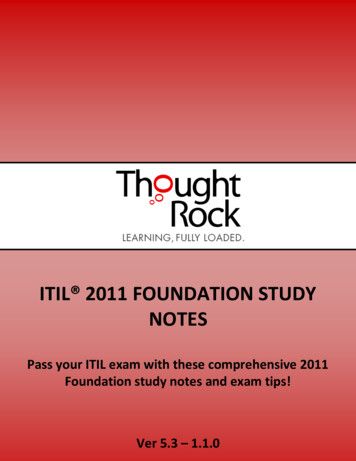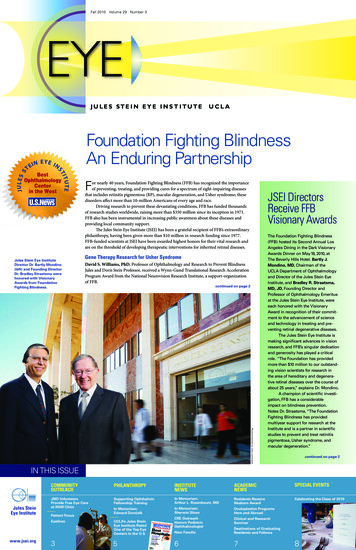
Transcription
Fall 2010 Volume 29 Number 3INTEUCLAFoundation Fighting BlindnessAn Enduring PartnershipEYE INSTJULES SJU LE S STE I N E Y E I N S T I TUTEITUTEBestOphthalmologyCenterin the WestU.S.News& WORLD REPORTJules Stein Eye InstituteDirector Dr. Bartly Mondino(left) and Founding DirectorDr. Bradley Straatsma werehonored with VisionaryAwards from FoundationFighting Blindness.For nearly 40 years, Foundation Fighting Blindness (FFB) has recognized the importanceof preventing, treating, and providing cures for a spectrum of sight-impairing diseasesthat includes retinitis pigmentosa (RP), macular degeneration, and Usher syndrome; thesedisorders affect more than 10-million Americans of every age and race.Driving research to prevent these devastating conditions, FFB has funded thousandsof research studies worldwide, raising more than 350 million since its inception in 1971.FFB also has been instrumental in increasing public awareness about these diseases andproviding local community support.The Jules Stein Eye Institute (JSEI) has been a grateful recipient of FFB’s extraordinaryphilanthropy, having been given more than 10 million in research funding since 1977.FFB-funded scientists at JSEI have been awarded highest honors for their vital research andare on the threshold of developing therapeutic interventions for inherited retinal diseases.JSEI DirectorsReceive FFBVisionary AwardsGene Therapy Research for Usher SyndromeDavid S. Williams, PhD, Professor of Ophthalmology and Research to Prevent BlindnessJules and Doris Stein Professor, received a Wynn-Gund Translational Research AccelerationProgram Award from the National Neurovision Research Institute, a support-organizationof FFB.continued on page 2Photocomposite by John LichtwardtThe Foundation Fighting Blindness(FFB) hosted its Second Annual LosAngeles Dining in the Dark VisionaryAwards Dinner on May 18, 2010, atThe Beverly Hills Hotel. Bartly J.Mondino, MD, Chairman of theUCLA Department of Ophthalmologyand Director of the Jules Stein EyeInstitute, and Bradley R. Straatsma,MD, JD, Founding Director andProfessor of Ophthalmology Emeritusat the Jules Stein Eye Institute, wereeach honored with the VisionaryAward in recognition of their commitment to the advancement of scienceand technology in treating and preventing retinal degenerative diseases.The Jules Stein Eye Institute ismaking significant advances in visionresearch, and FFB’s singular dedicationand generosity has played a criticalrole. “The Foundation has providedmore than 10 million to our outstanding vision scientists for research inthe area of hereditary and degenerative retinal diseases over the course ofabout 25 years,” explains Dr. Mondino.A champion of scientific investigation, FFB has a considerableimpact on blindness prevention.Notes Dr. Straatsma, “The FoundationFighting Blindness has providedmultiyear support for research at theInstitute and is a partner in scientificstudies to prevent and treat retinitispigmentosa, Usher syndrome, andmacular degeneration.”continued on page 2In this IssueJules SteinEye sACADEMICnewsspecial eventsJSEI VolunteersProvide Free Eye Careat RAM ClinicSupporting OphthalmicFellowship TrainingIn Memoriam:Arthur L. Rosenbaum, MDResidents ReceiveNesburn AwardCelebrating the Class of 2010In Memoriam:Edward DominikIn Memoriam:Sherwin SloanOculoplastics ProgramsHere and AbroadCRE OutreachHonors PediatricOphthalmologistClinical and ResearchSeminarPatient FocusEyelineswww.jsei.org3UCLA’s Jules SteinEye Institute RatedOne of the Top EyeCenters in the U.S.5New FacultyDestinations of GraduatingResidents and Fellows678
Foundation Fighting Blindnesscontinued from page 1Usher syndrome is an inherited condition that results in hearing lossand a progressive loss of vision from RP. The hearing loss is thought to becongenital, and ranges from moderate to profound, and may or may not beprogressive. Usher IB is especially devastating, since vision loss occurs inyoung patients who already suffer from profound deafness.Dr. Williams explains, “Usher 1B is caused by loss of function of theMYO7A (myosin VIIa) gene. In the retina, this gene is expressed in boththe photoreceptor cells and the retinal pigment epithelium. The proposedapproach involves the subretinal delivery of MYO7A cDNA in a viral vectorto treat these two cell types.”The completion of the studies supported by this grant is expected tolead to a Phase I clinical trial for replacement therapy of Usher 1B fromMYO7A mutations.Gaining a Greater Understanding of Stargardt DiseaseFFB-funded research to understand the characterization of Stargardt andStargardt-like macular dystrophies is being led by principal investigator, Michael B. Gorin, MD, PhD, Harold and Pauline Price Professor ofOphthalmology, and co-investigators Debora B. Farber, PhD, DPhhc,Karl Kirchgessner Foundation Professor of Ophthalmology, and StevenNusinowitz, PhD, Associate Professor of Ophthalmology. Their researchaddresses four clinical objectives in diagnosing and treating this form ofjuvenile macular degeneration and other macular dystrophies.Dr. David Williams received a Wynn-Gund Translational Research AccelerationProgram Award from the National Neurovision Research Institute, a supportorganization of FFB, to develop a gene therapy for the retinal degeneration inUsher syndrome type 1B.Foundation Fighting Blindness Awards Top HonorDean Bok, PhD, Dolly Green Professor of Ophthalmology, received theLlura Liggett Gund Award, the top honor presented by FFB.Only four researchers in FFB’s 39-year history have received thisaward, which recognizes visionaries in the retinal research communitywhose achievements have significantly advanced knowledge of retinaldegenerative diseases.Dr. Bok is a world-renowned expert in defining how vitamin A metabolism is essential to vision. His research helped establish the gene defect in thevitamin A metabolic cycle, directing researchers toward recent successful genetherapy clinical trials for Leber congential amaurosis, a severe, early onsetform of RP. His research also has led to industry projects focused on treatments for age-related macular degeneration, Stargardt disease, and otherinherited retinal degenerations.Gordon Gund, Chairman and Co-Founder of FFB, commented, “Formore than four decades, Dr. Bok’s superlative research contributions to understanding the causes of these diseases, his mentorship of and collaboration withothers, and his dedicated commitment to the development and oversight ofFFB’s strategic research plan highly qualify him for this singular recognition.”JSEI Directors Receive FFB Visionary Awardscontinued from page 1VisionWalkDr Dean Bok, 2007 LosAngeles VisionWalkHonorary Chair, speaksto FFB supporters whohave gathered to walkfor a cure.JSEI’s close collaboration with FFB reaches beyond the laboratory and into thecommunity, where JSEI is a lead sponsor of VisionWalk, the FFB’s 5K walk-athon, which raises moneys in support of the its mission.Beginning with the 2007 inaugural Los Angeles VisionWalk, hundreds ofsupporters have gathered annually to walk for a cure. JSEI vision scientist andpast honorary chair, Dean Bok, PhD, and members of the JSEI Affiliates Teamhelped FFB get out its hopeful message to the community, “A Cure is in Sight.”From left, JSEI faculty members Drs. Bartly Mondino, Dean Bok,Gary Holland, and Bradley Straatsma, and FFB Chief DevelopmentOfficer Jim Minow at the “Dining in the Dark” eventResearch is the cornerstone of the Jules SteinEye Institute’s academic mission, and Dr. Mondino andDr. Straatsma have devoted their life’s work to furtheringknowledge of specific vision processes and degenerativeeye diseases, aspiring to eradicate global blindness.Leading the academic pursuits of the Institute’sfaculty and trainees for the past16 years, Dr. Mondinoalso treats patients and conducts research in the areaof inflammatory and infectious eye diseases. He haspublished extensively on autoimmune diseases of theexternal eye and contact-lens-related corneal ulcers. Heserves as Executive Vice President of the Association ofUniversity Professors of Ophthalmology and as a MedicalAdvisory Board Member of the Board of Directors forthe Braille Institute.Dr. Straatsma commenced his faculty appointment at UCLA in 1959. He was appointed Professor in1962, Director of the Jules Stein Eye Institute in 1964, andChairman of the Department of Ophthalmology in 1968,where he remained until 1994. In 2002, Dr. Straatsma graduated from the University of West Los Angeles School ofLaw (JD, Cum Laude). Currently, he is a Member of theInternational Council of Ophthalmology and President ofthe International Council of Ophthalmology Foundation.The evening included a meal served in complete darkness by sight-impaired or blind wait staff and a live auction,which raised more than 161,000 for research.EYE Jules Stein E y e Institute Fall 2010 Page 2
Community OutreachJSEI VolunteersProvide Free Eye Care at RAM ClinicThe Jules Stein Eye Institute sentthe UCLA Mobile Eye Clinic alongwith 53 volunteers to provide eyecare services at the event.Approximately 7,000 patients attended the 2010Remote Area Medical Clinic in Los Angeles.The UCLA Mobile Eye Clinic (MEC) drove into anempty L.A. Sports Arena at 6:00 a.m. on Sunday,April 25, 2010, to take part in the Remote Area Medical(RAM) free clinic. From April 27–May 3, the floor ofthe Sports Arena—a venue that has seen everythingfrom political speeches to Olympic boxing to BruceSpringsteen concerts—would be transformed into a vastfield hospital, filled with a small army of volunteer medical professionals and thousands of prospective patientswaiting for the chance to receive everyday heathcareservices that many Americans take for granted.RAM is a publicly supported, all-volunteer, charitable organization whose original mission was to deliverbasic medical aid to people in the world’s inaccessibleregions. Recently, RAM has begun working in urbanareas as well. Last year, the organization held its first LosAngeles-based clinic at the Forum in Inglewood. Theunmet demand for healthcare prompted RAM to returnto Los Angeles this year for an unprecedented secondhealth clinic.“This is the second time that RAM has organizeda free health clinic in Los Angeles and the second timethat the Jules Stein Eye Institute (JSEI) has participated,”said Anne L. Coleman, MD, PhD, MEC Director and aprincipal coordinator of the JSEI effort. “The crowds atthe Sports Arena are a testament to the healthcare crisisin Los Angeles,” she commented.Anticipating an even greater demand for eye careservices this year, Dr. Coleman, along with JSEI DirectorBartly J. Mondino, MD, recruited 40 ophthalmologistsand 13 ophthalmic technicians to volunteer at the clinic.They also sent the MEC, a 39-foot-long bus specially outfitted with eye examination equipment.“Reaching out to the underserved in the community is part of our mission. The response to our call foraction from faculty and staff highlights the tremendousdedication to community service from the JSEI family,”said Dr. Mondino.“Reaching out to theunderserved in thecommunity is part of ourDr. Jennifer Huang examines a patient on the MobileEye Clinic. An estimated 1,500 patients were seen in theophthalmology area.The weeklong RAM clinic served close to 7,000patients; approximately 1,000 people were admitted daily.For many, it was their only chance to see primary-caredoctors, dentists, ophthalmologists, and other specialists.UCLA staff from the schools of medicine, nursing anddentistry as well as from JSEI, among others, showed upin force.The MEC, parked at one end of the arena floor,anchored the ophthalmology area. A row of slit lampswas set up on the floor of the arena nearby, shieldedfrom the bright lights by curtains. Everyone over 40 yearsof age, as well as younger people at risk for eye disease,received a slit lamp exam. Dilated eye exams were done asneeded in the MEC. By the end of the week, an estimated1,500 patients were seen in the ophthalmology area.The RAM clinic was an extraordinary example ofLos Angeles coming together, as a community, to providebasic healthcare to the medically underserved. More than60 organizations and community groups, large and small,contributed all of the medical resources and volunteers tohelp make this clinic a tremendous success.Commenting on the experience, Dr. Coleman said,“RAM 2010 Los Angeles was an extraordinary displayof volunteerism coupled with deeply grateful patients.While a weeklong clinic is not a cure-all for our community’s healthcare problems, we were thrilled to contributeto providing needed eye services to these thousands ofuninsured and under-insured patients.”EYE Jules St ein E y e Institute Fall 2010 Page 3mission. The responseto our call for action fromfaculty and staff highlightsthe tremendous dedicationto community service fromthe JSEI family,” saidDr. Mondino.
Patient FocusJSEI Patient Calls Novel Surgery “Life-Changing”Charles Haverstick could never have imagined that aflag football game 27 years ago would affect his life sodramatically. An eye injury sustained when he was tryingto intercept a ball left him without a functioning iris andyears of extreme sensitivity to light.“I was running downfield looking up and back tointercept a ball when an opposing player running theother way swung his hand to deflect the ball. The edge ofhis hand hit me directly on the eye like a karate chop. Theforce of the blow broke some bones behind the eye andtore the muscle of the iris,” he explains.The iris—the colored part of the eye—is a ring ofmuscle fibers that automatically contracts and expands,opening and closing the pupil, in response to thebrightness of surrounding light. The eye injury leftMr. Haverstick’s right eye with a nonfunctional iris.It was completely dilated open, leaving his pupilunprotected from glare and sunlight. It also gave him asomewhat unusual appearance. He had one blue eye andone that had turned completely black from the injury.“I got used to people doing double-takes when theysaw my eyes. But I couldn’t get over the effect of lightflooding into my eye all of the time. It was painful, and Isuffered from constant headaches and migraines,” he said.Mr. Haverstick, who works with computers andcoaches a swim team, tried to limit his exposure to brightcomputer screens and wore sunglasses even on cloudydays. When a veterinarian told him about Kevin M.Miller, MD, an ophthalmologist at the Jules Stein EyeInstitute who was performing iris replacement surgery,he called and set up an appointment almost immediately.Dr. Miller is only the second surgeon in the UnitedStates to implant a custom artificial iris. Previously, irisimplants were flat in color, almost mask-like. While thecustom implant won’t open and close like a natural iris,it limits the light that comes into the eye and addressesthe cosmetic aspect of the eye color. It represents a majorleap forward in the cosmetic treatment of patients withmissing iris tissue.“This has been a life-changingexperience. I am able to do thingsthat I had not been able to dofor 27 years When I originallycontacted Dr. Miller, I did not carehow my eye would look after thesurgery. It is strange to look in themirror and see myself with twoeyes of the same color. The implantis amazing in its detail.”Charles Haverstick, the grateful recipient of a custom artificial irisAsked how the artificial implant has changed his life,Mr. Haverstick replies, “This has been a life-changing experience.I am able to do things that I had not been able to do for 27 years.I can go for a run at sunrise without racing back before the sunactually comes up. I can swim outdoors without having a headachelater. I can go to a swim meet and take my sunglasses off to look atmy swimmers when I talk to them. When I originally contactedDr. Miller, I did not care how my eye would look after the surgery.It is strange to look in the mirror and see myself with two eyes ofthe same color. The implant is amazing in its detail.”Pre-surgery photoThe implant of the custom artificial iris created by HumanOptics AGwas performed under a “compassionate use” exemption from the Foodand Drug Administration (FDA). Dr. Miller plans to begin clinicaltrials with the custom artificial iris device and hopes to get FDAapproval within five-to-six years.EYELIN ESUCLA Department of Ophthalmology AssociationAnnounces New OfficersThe UCLA Department of Ophthalmology Associationrecently announced new officers for the 2010–2012term. Michael J. Groth, MD (Resident Class of 1988),Assistant Clinical Professor of Ophthalmology, hasassumed the role of President, and Stanley M. Saulny,MD (Resident Class of 2001), will serve as the new VicePresident. Robert Alan Goldberg, MD, Professor ofOphthalmology, will continue to serve as Treasurer andSecretary for the next two years.Robert E. Engstrom, MD, Assistant ClinicalProfessor of Ophthalmology, is the outgoing president,having served as Vice President from 2006–2008 andPresident from 2008–2010. Dr. Engstrom was acknowledged for his dedication and contributions to theAssociation at the Jules Stein Eye Institute’s graduationceremonies in May 2010.Dr. Groth is a board-certified ophthalmologistspecializing in ophthalmic plastic and reconstructive surgery. He completed his residency and fellowship trainingat the Jules Stein Eye Institute after graduating from medical school at the University of Miami. In 1989, Dr. Grothestablished his private practice in Beverly Hills, which islimited to ophthalmic plastic and reconstructive surgery.He continues to teach and supervise residents and fellows as Associate Clinical Professor at the Jules Stein EyeInstitute in addition to acting as a Clinical Instructor atthe West Los Angeles VA Healthcare Center. Dr. Grothalso contributes to various medical journals with publications relating to his special interest in blepharoplasty(eyelid surgery). Dr. Grothis involved in the Iraq StarFoundation, a non-profitorganization that providesreconstructive surgery forwounded Iraq war veterans.Dr. Michael Groth,UCLA Department ofOphthalmology Association’s2010–2012 President2010 Robert E. Christensen, MD,Research AwardWinners AnnouncedThe UCLA Department of Ophthalmology Associationis pleased to announce that the Orbital and OphthalmicPlastic Surgery fellow Holly Chang, MD, is the winner ofthe 2010 Robert E. Christensen, MD, Research Award ofthe UCLA Department of Ophthalmology Association.Current third-year resident Amelia Chen Sheh, MD,also received research funding. The annual award, in recognition of an outstanding research proposal presentedby a Jules Stein Eye Institute (JSEI) resident or fellow,is named in honor of Robert Christensen, MD, the latefounding Chief of the Glaucoma Division.EYE Jules Stein E y e Institute Fall 2010 Page 4The 2010 grant will help underwrite Dr. Chang’sresearch of orbital and ocular inflammation and specifically allow for the purchase of much-needed equipmentand supplies to study this visually debilitating disease.The 2010 grant also will fund Dr. Sheh’s study of intraoperative floppy iris syndrome.All current JSEI residents and fellows are eligibleto apply for the annual grant. Robert Alan Goldberg,MD, UCLA Department of Ophthalmology AssociationSecretary and Treasurer, noted, “The award, being presented for the fourteenth year in a row, is made possible by funding from annual UCLA Department ofOphthalmology Association dues, generously paid byJSEI alumni and faculty.”Dr. Holly Chang,“Elucidating the role ofIgG4 in orbital and ocularinflammation”Dr. Amelia Chen Sheh,“Role of alpha-1a adrenergicreceptor antagonistson surgical outcomesand complication ratesin resident-performedphacoemulsificationsurgery”
Ph i l a n t h r o p ySupporting Ophthalmic Fellowship TrainingPhoto: Chuck GardnerLooking across their urban garden filled with berries,vegetables, and fruit trees of every variety, David R. Fett,MD, and hi
tor, Michael B. Gorin, MD, PhD, Harold and Pauline Price Professor of Ophthalmology, and co-investigators Debora B. Farber, PhD, DPhhc, Karl Kirchgessner Foundation Professor of Ophthalmology, and Steven Nusinowitz, PhD, Associate Professor of Ophthalmology. Their research addresses four cl
